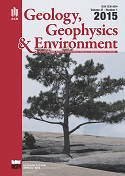Microdiamonds in paragneisses from the allochthonous unit of the Swedish Caledonides: precious testimony of the UHP metamorphism
DOI:
https://doi.org/10.7494/geol.2015.41.1.94Keywords:
Diamond, Moissanite, Seve Nappe Complex, Ultrahigh-pressure metamorphismAbstract
The highest grade allochthonous unit in the Scandinavian Caledonides is represented by the Seve Nappe Complex (SNC) that belongs to the Middle Allochthon. This unit is interpreted to be derived from the outermost margin of Baltica that is dominated by metasediments and amphibolites. Eclogites, peridotites and migmatites occur only locally. Nonetheless, detailed field studies followed by comprehensive analytical investigations of high grade rocks within the SNC led to the discovery of the ultra-high pressure metamorphism (UHPM) within eclogites, garnet pyroxenites and paragneisses from central and northern Jämtland in Sweden (e.g. Janák et al. 2013; Klonowska et al. 2014, 2015; Majka et al. 2014). Diamond, in addition to coesite, is an index mineral for the UHPM and the first microdiamonds in the SNC of the Swedish Caledonides were recently discovered in paragneisses from the Snasahögarna Mt. (Majka et al. 2014). After this discovery, reinvestigation of gneiss samples from the Åreskutan Mt., the classical area, where thrusting was defined for the first time in the Scandes (Törnebohm 1888) and where the UHPM has been lately indicated by the thermodynamic modelling (Klonowska et al. 2014), resulted in findings of microdiamond inclusions in garnets.
Microdiamonds were identified by the Raman microspectroscopy in two gneiss samples and they range in size between 1 and 3µm. Partial transformation of diamond to the disordered graphite is a common feature observed in these inclusions. Microdiamonds are found as single grains as well as multiphase inclusions together with disordered graphite and carbonates. Aside from microdiamond inclusions, single grain of moissanite, a natural form of SiC, has been also identified. Moissanite inclusion is 3µm across and exhibits negative crystal shape. In-situ moissanite has been found only in few places so far, including rocks from the ultra-high pressure terranes, eclogite and serpentinite from the Dabie-Sulu orogenic belt in China (Qi et al. 2007, Xu et al. 2008), dunite from Luobusa ophiolite in Tibet (Liang et al. 2014) and felsic granulites from Bohemian Massif (Perraki and Faryad 2014).
Findings of the microdiamond inclusions in the allochthonous rocks that represent continental crust indicate the UHP metamorphism and subduction to mantle depths (>100km), whereas the occurrence of moissanite points to the highly-reducing conditions during this deep subduction. Increased number of discoveries of the UHPM in the SNC shed a new light on the subduction-exhumation processes involved in a formation of the Caledonian mountain chain in Scandinavia. A new tectonic model for this orogenic belt has been recently proposed by Majka et al. (2014), where authors introduce a ‘vacuum cleaner mechanism’ being responsible for an exhumation of the deeply subducted rocks.Downloads
References
Janák M., Van Roermund H.L.M., Majka J. & Gee D.G., 2013a. UHP metamorphism recorded by kyanite-bearing eclogite in the Seve Nappe Complex of northern Jämtland, Swedish Caledonides. Gondwana Research, 23, 865-879.
Klonowska I., Janák M., Majka J., Froitzheim N & Kośminska K., 2015. New discoveries of the UHP rocks in the Seve Nappe Complex (Swedish Caledonides) and their under-pressure–driven exhumation. XI International Eclogite Conference 2015, 31 January-7 February 2015, Dominican Republic, Abstract Volume, available online.
Klonowska I., Majka J., Janák M., Gee D.G. & Ladenberger A., 2014. Pressure-temperature evolution of a kyanite-garnet pelitic gneiss from Åreskutan: evidence of (U)HP metamorphism of the Seve Nappe Complex, west-central Jämtland, Swedish Caledonides. In: Corfu F., Gasser D. & Chew D. M. (eds) New Perspectives on the Caledonides of Scandinavia and Related Areas. Geological Society, London, Special Publications, 390, 321–336.
Liang F.H., Xu Z.Q. & Zhao J.N., 2014. In-situ moissanite in dunite: Deep mantle origin of mantle peridotite in Luobusa ophiolite, Tibet, Acta Geologica Sinica (English Edition), 88, 517-529.
Majka J., Rosén Å., Janák M., Froitzheim N., Klonowska I., Manecki M., Sasinková V. & Yoshida K. 2014. Microdiamond discovered in the Seve Nappe (Scandinavian Caledonides) and its exhumation by the “vacuum-cleaner” mechanism, Geology, 42, 1107-1110.
Perraki M., & Faryad S.W., 2014. First finding of microdiamond, coesite and other UHP phases in felsic granulites in the Moldanubian Zone: Implications for deep subduction and a revised geodynamic model for Variscan Orogeny in the Bohemian Massif. Lithos, 202–203, 157–166.
Törnebohm A.E., 1888. Om fjällproblemet. Geologiska Föreningens i Stockholm Förhandlingar, 824, 328–336.
Qi X.X., Yang J.S., Xu Z.Q., Bai W.J., Zhang Z.M., Fang Q.S., 2007. Discovery of moissanite in retrogressive eclogite from the pre-pilot hole of the Chinese continental scientific drilling project (CCSD-PP2) and its geological implication. Acta Petrologica Sinica, 23, 3207–3214 (in Chinese with English abstract).
Xu S.T., Wu W.P., Xiao W.S., Yang J.S., Chen J., Ji S.Y., 2008. Moissanite in serpentinite from the Dabie Mountains in China. Mineralogical Magazine, 72, 899–908.
Downloads
Published
Issue
Section
License
Authors have full copyright and property rights to their work. Their copyrights to store the work, duplicate it in printing (as well as in the form of a digital CD recording), to make it available in the digital form, on the Internet and putting into circulation multiplied copies of the work worldwide are unlimited.
The content of the journal is freely available according to the Creative Commons License Attribution 4.0 International (CC BY 4.0)










